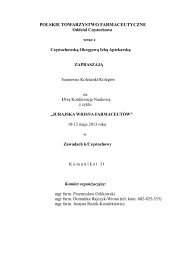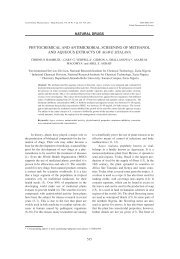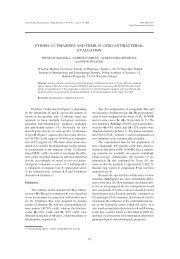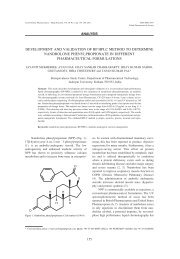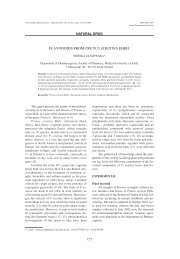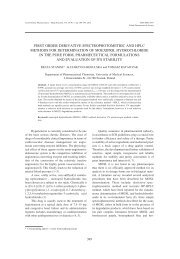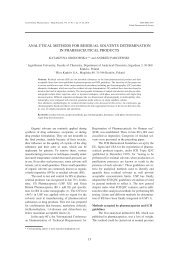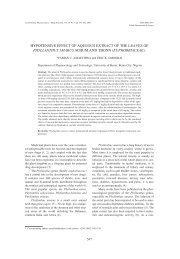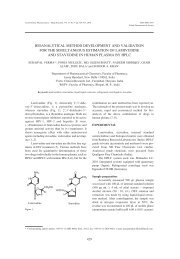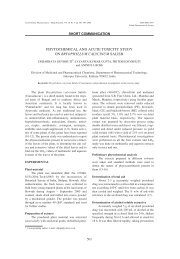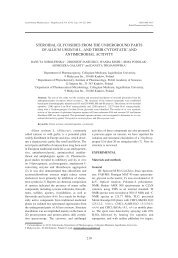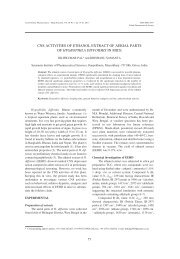CYTOTOXIC EFFECT OF SOME MEDICINAL PLANTS FROM ...
CYTOTOXIC EFFECT OF SOME MEDICINAL PLANTS FROM ...
CYTOTOXIC EFFECT OF SOME MEDICINAL PLANTS FROM ...
You also want an ePaper? Increase the reach of your titles
YUMPU automatically turns print PDFs into web optimized ePapers that Google loves.
Acta Poloniae Pharmaceutica ñ Drug Research, Vol. 69 No. 2 pp. 263ñ268, 2012 ISSN 0001-6837<br />
Polish Pharmaceutical Society<br />
NATURAL DRUGS<br />
<strong>CYTOTOXIC</strong> <strong>EFFECT</strong> <strong>OF</strong> <strong>SOME</strong> <strong>MEDICINAL</strong> <strong>PLANTS</strong> <strong>FROM</strong> ASTERACEAE<br />
FAMILY ON J-45.01 LEUKEMIC CELL LINE ñ PILOT STUDY<br />
MAGDALENA WEGIERA*, HELENA D. SMOLARZ, MARCIN J DRUCH, MAGDALENA KOR-<br />
CZAK and KAMILA KOPRO—<br />
Chair and Department of Pharmaceutical Botany, Medical University, 20-093 Lublin, Poland<br />
Abstract: In this study the in vitro cytotoxic properties of ethanol extracts from the herbs, inflorescents and<br />
roots of selected Asteraceae species: Arctium lappa, Artemisia absinthium, Calendula officinalis, Centaurea<br />
cyanus, Tanacetum vulgare and Tragopogon pratensis on J-45.01 human acute T leukemia cell line was examined.<br />
All tested samples possess antileukemic properties and induce cells death via apoptosis. The correlation<br />
between antileukemic activity and total polyphenol content was determined.<br />
Keywords: Asteraceae, J-45.01, leukemic cell line, cytotoxic properties, polyphenol content<br />
The Asteraceae family occurs commonly in the<br />
world (about 25.000 species) and in Poland is represented<br />
by about 333 species. The species are a<br />
source of many biologically active compounds like<br />
essential oils (1ñ4), polyphenolic compounds (5, 6),<br />
flavonoids (5ñ11), terpenoids (8ñ10, 12ñ17), phenolic<br />
acids (7, 10, 18), alkaloids (19), lignans (7),<br />
saponins (8, 15, 20), stilbenes, sterols (10), polysaccharides<br />
(12) and many others.<br />
Due to their bio-active properties plants from<br />
Asteraceae family are commonly used in treatment<br />
of various diseases. Artemisia absinthium L.<br />
(known as wormwood) is a well known in many<br />
countries for her healing properties. It acts insecticidally,<br />
antihelminthically (1, 13), antimalarially<br />
(14, 21), antiseptically (22) and shows anti-inflammatory<br />
and antioxidant properties (22). Wormwood<br />
has been also used for a long time in traditional<br />
medicines for cardiac stimulation (22), the treatment<br />
of gastric pain, to stimulate appetite, digestion<br />
(2, 21, 22) and to improve memory and mental<br />
function (22). Arctium lappa L. (burdock) is especially<br />
known in traditional Chinese medicine (7).<br />
This plant is a rich source of flavonoids and lignans<br />
and it is helpful in the treatment of inflammatory<br />
disorders. Moreover, it has been used as an antiaging,<br />
antioxidant, antimutagenicity, anticarcinogenicity<br />
and antitumoral remedy (7, 23). Calendula<br />
officinalis L. has found many medicinal applications<br />
both in Europe and in America (20). Many<br />
studies have shown that it possesses anti-inflammatory,<br />
antiseptic, antimicrobial, diaphoretic, antispasmodic<br />
and tonic properties and also has the<br />
ability to heal eruptive skin diseases and abrasions<br />
(15, 16, 20). Saponin-rich extract from Calendula<br />
officinalis was found to have cytotoxic and antitumoral<br />
activity (18). Anti-HIV properties of extracts<br />
from Calendula officinalis flowers were observed<br />
as well (9). Another species from the wide range of<br />
Asteraceae family, which has been found many<br />
applications both in folk and modern medicine, is<br />
Tanacetum vulgare L. Extracts from this species<br />
have been used for treating many health problems<br />
such as digestive disorders, rheumatism, fever and<br />
ulcers (12). It acts anti-inflammatorily (11, 12, 24)<br />
and also has been reported to have antimicrobial,<br />
antitumor and antioxidant properties (24).<br />
Tragopogon pratensis L. shows diaphoretic and<br />
antitussive properties (25).<br />
As shown above, some species of the<br />
Asteraceae family are used as remedies for many<br />
health problems, including tumor diseases, which<br />
are the second most common cause of death.<br />
The objective of this study was to examine the<br />
in vitro cytotoxic properties of ethanol extracts from<br />
the herbs, inflorescents and roots of the selected<br />
Asteraceae species: Arctium lappa, Artemisia<br />
absinthium, Calendula officinalis, Centaurea<br />
* Corresponding author: e- mail: m.wegiera@am.lublin.pl<br />
263
264 MAGDALENA WEGIERA et al.<br />
cyanus, Tanacetum vulgare and Tragopogon pratensis<br />
against J-45.01 human T cell leukemia cell line.<br />
MATERIALS AND METHODS<br />
Plant material<br />
The different plant organs from selected<br />
species of the Asteraceae family were used in this<br />
study: roots and herbs of Arctium lappa (RAc, HAc),<br />
roots and herbs of Artemisia absinthium (RAt, HAt),<br />
herbs and inflorescents of Centaurea cyanus (HCe<br />
and ICe) and roots, herbs and inflorescents of<br />
Calendula officinalis (RCa, HCa and ICa),<br />
Tanacetum vulgare (RTa, HTa and ITa) and<br />
Tragopogon pratensis (RTr, HTr and ITr). These<br />
abbreviations are consistently used in the text. The<br />
plant samples were collected from natural habitat at<br />
the end of June (herbs), July (inflorescents) and in<br />
the September (roots) of 2009, near Lublin (Poland).<br />
Voucher specimens were deposited at the Chair and<br />
Department of Pharmaceutical Botany, of the<br />
Medical University of Lublin (Poland).<br />
Plant extraction<br />
One gram of air-dried and powdered plant<br />
material was extracted with 35 mL of 70% aqueous<br />
methanol solution. The extraction was carried out<br />
for 1 h in boiling water bath using a cooler. The<br />
received extract was cooled down to room temperature<br />
and filtered to 100 mL volumetric flask.<br />
Then, the material remaining was extracted again<br />
with 70% aq. methanol solution in the same conditions<br />
as before. After filtering, the obtained mixtures<br />
were combined in volumetric flask and filled<br />
to 100 mL with distilled water (extract A). Extract<br />
A was used for phytochemical analysis to determine<br />
the total polyphenol content. A part of the<br />
extract A (50 mL) was evaporated and condensed<br />
in liquid nitrogen to dry residue (extract B, subject<br />
to biological assay).<br />
Cell lines and culture medium<br />
The J-45.01 cell line (Jurkat; human acute T<br />
leukemia cell line from ECACC, cat. no. 88042803)<br />
was used in this work. It was cultured by ECACC<br />
protocol at the concentration of 5 ◊ 10 5 cells/mL. All<br />
cultures were grown in an incubator (Biotech) in<br />
humifidied atmosphere of 5% CO 2 , for 24 h at 37 O C.<br />
The growing medium consisted of: RPMI 1640<br />
medium (Sigma, St. Louis, USA), 10% heat inactivated<br />
fetal bovine serum (Sigma, St. Louis, USA), 2<br />
mM L-glutamine and antibiotics: penicillin (100<br />
U/mL), streptomycin (100 µM/mL) and amphotericin<br />
B (2.5 µg/mL) (Gibco, Carlsbad, USA).<br />
Trypan blue assay<br />
The J-45.01 cells in concentration 5 ◊ 10 5<br />
cells/mL were stimulated in vitro with various concentrations<br />
of ethanol extracts (0.04ñ1.0 mg/mL).<br />
The cells were incubated for 24 h at 37 O C in humidified<br />
atmosphere of 5% CO 2 . At the end of this period,<br />
the medium from each plate was removed by<br />
aspiration. Then, 10 µL suspension of the cells were<br />
incubated for 5 min with 10 µL of 0.4% trypan blue<br />
solution (Sigma). Thereafter, the presence of nonviable<br />
cells, which were dark blue and viable cells,<br />
which excluded the dye, was analyzed in Olympus<br />
BX41 microscope. The study was an average of 10<br />
randomly selected fields in the preparation, so that<br />
the sum of all cells was not less than 200. The percentage<br />
of viable cells in controls was higher than<br />
95%. The IC 50 doses (concentrations at which cell<br />
viability was 50%) were set by means of MS Excel<br />
spreadsheet, using data received from tree independent<br />
test.<br />
Annexin V assay<br />
The Annexin V assay (Pharmingen, San Diego,<br />
USA) was used to estimate the number of cells in<br />
the early and late stages of apoptosis (according of<br />
manufacturer protocol). The 24-h cell cultures were<br />
centrifuged at 800 rpm for 10 min at room temperature<br />
and the culture medium was removed. Then,<br />
they were incubated for 10 min in the buffer comprising<br />
10 mM Hepes [N-(2-hydroxyethyl)piperazine-Ní-(2-ethanesulfonic<br />
acid) hemisodium<br />
salt]/NaOH, pH 7.4, 140 mM NaCl, 2.5 mM CaCl 2 ,<br />
annexin V labelled with 0.65 µg/mL of FITC and<br />
propidium iodide (12 µg/mL). Thereafter, samples<br />
were analyzed by an Olympus BX41 light and fluorescence<br />
microscope for the presence of viable cells<br />
(annexin V ñ /PI ñ ); early apoptotic (annexin V + /PI ñ )<br />
and late apoptotic/necrotic cells (annexin V + /PI + ).<br />
Fluorescein isothiocyanate-labeled annexin V could<br />
bind the outer membranes of apoptotic cells and discriminate<br />
apoptotic cells in the early stage from<br />
necrotic cells when used with propidium iodide. The<br />
extracts mediated apoptosis was expressed as the<br />
percentage of apoptotic cells/total cells. Cell morphology<br />
using a BX41 Olympus light and fluorescence<br />
microscope was also examined. Data were<br />
processed according to the MultiScan software. All<br />
the samples were analyzed at the concentrations<br />
close to IC 50 values or at the concentration with 50%<br />
of living cells in breeding.<br />
Determination of total polyphenols<br />
The determination of a total polyphenol compounds<br />
in the examined species was carried out
Cytotoxic effect of some medicinal plants from Asteraceae family... 265<br />
according to the spectrocolorimetric method (26).<br />
One mL of sample solution was added to 4 mL of<br />
distilled water and 1 mL of Folin-Ciocalteau<br />
reagent. After 3 min, 4 mL of Na 2 CO 3 (70 g/L) was<br />
added. The absorption of the blue color was measured<br />
at 660 nm. The concentration of phenols in the<br />
sample was estimated from standard curve of gallic<br />
acid in the concentration range of 10ñ70 mg/L.<br />
Results were expressed as gallic acid equivalents<br />
(mg gallic acid equivalents/g dried extract). All<br />
samples were analyzed in six replications.<br />
Statistical analysis<br />
All results are expressed as the mean of tree to<br />
six experiments. The relationship between<br />
antileukemic properties and the total polyphenol<br />
content was evaluated in two ways: graphically with<br />
MS Excel and statistically with GraphPad In Stat 3<br />
software, where the Spearman rank correlation coefficient<br />
(r) was determined. Values of p < 0.05 were<br />
considered statistically significant.<br />
RESULTS AND DISCUSSION<br />
The effect of ethanol extracts from different<br />
part of six species of Asteraceae family on J-45.01<br />
human acute T leukemia cell line was examined.<br />
The cytotoxicity with trypan blue exclusion test was<br />
conducted in a range of concentrations (0.04ñ1.0<br />
mg/mL) to determined the IC 50 value (after 24 h<br />
stimulation). The received IC 50 values are reported<br />
in Table 1.<br />
The strongest antileukemic activity was found<br />
for the inflorescences of Tanacetum vulgare, for<br />
which the IC 50 dose of 0.20 mg/mL was determined.<br />
Large cytotoxic activity was also recorded for the<br />
roots of Calendula officinalis (IC 50 = 0.23 mg/mL)<br />
and for the herb of Centaurea cyanus (IC 50 = 0.25<br />
mg/mL). Similar antileukemic properties (IC 50 =<br />
0.33ñ0.38 mg/mL) were shown by the herbs and<br />
roots of Arctium lappa, Tanacetum vulgare, the<br />
herbs of Artemisia absinthium, Tragopogon pratensis<br />
and the inflorescences of Calendula officinalis.<br />
The largest IC 50 value characterized the inflorescences<br />
of Centaurea cyanus (0.77 mg/mL).<br />
Apoptotic effect of plant extracts was estimated<br />
by annexin V assay. Annexin V and propidium<br />
iodide stained the cells with impaired integrity of the<br />
plasma and nucleus membrane. The J-45.01 cells<br />
were stimulated by the extracts at a concentration<br />
close to the IC 50 value. On the basis of the characteristic<br />
morphological changes in the stimulated<br />
leukemic cells intensive apoptotic response was<br />
observed.<br />
In this experiment, after 24 h extract stimulation,<br />
we found similar number of living cells in all<br />
analyzed cell cultures (46.33ñ50.97%). The number<br />
of cells in the early stages of apoptosis ranged from<br />
Table 1. IC 50 values and total polyphenol content of ethanol extracts from Asteraceae family.<br />
Plant sample<br />
IC 50 value<br />
Total polyphenol content<br />
[mg/mL]*<br />
[mg/g gallic acid]**<br />
RAc 0.35 ± 0.032 23.50 ± 1.766<br />
RAt 0.60 ± 0.054 7.30 ± 0.904<br />
RCa 0.23 ± 0.018 4.38 ± 0.787<br />
RTa 0.30 ± 0.019 24.00 ± 2.472<br />
RTr 0.64 ± 0.045 4.18 ± 0.854<br />
HAc 0.34 ± 0.021 22.93 ± 1.271<br />
HAt 0.35 ± 0.022 22.36 ± 1.393<br />
HCa 0.41 ± 0.013 11.12 ± 1.255<br />
HCe 0.25 ± 0.017 20.43 ± 3.106<br />
HTa 0.36 ± 0.021 30.42 ± 2.051<br />
HTr 0.38 ± 0.018 16.23 ± 1.608<br />
ICa 0.33 ± 0.013 16.69 ± 0.929<br />
ICe 0.77 ± 0.040 12.49 ± 1.335<br />
ITa 0.20 ± 0.008 39.39 ± 3.790<br />
ITr 0.66 ± 0.033 35.41 ± 2.432<br />
* (n = 3), ** (n = 6)
266 MAGDALENA WEGIERA et al.<br />
Figure 1. Amount of living (A), early apoptotic (E), late apoptotic and necrotic (L/N) J-45.01 cells after 24 h stimulation at IC 50 values.<br />
The number of cells was determined by the annexin V-FITC labelled and propidium iodide test. Data are the means of 3 different experiments<br />
and are expressed as the percentage of the control<br />
Figure 2. Amount of living (A), early apoptotic (E), late apoptotic and necrotic (L/N) J-45.01 cells after 4 and 48 h stimulation at IC 50 values.<br />
Description: A) A. lappa, B) A. absinthium, C) C. officinalis, D) C. cyanus, E) T. vulgare and F) T. pratensis. The number of cells was<br />
determined by the annexin V-FITC labelled and propidium iodide test. Data are the means of 3 different experiments and are expressed as<br />
the percentage of the control<br />
36.20 to 39.90%, while the number of cells in the<br />
late stage apoptotic and necrotic cells were differentiated<br />
(average value for all samples was 20.27%).<br />
The percentage of early and late apoptotic J-45.01<br />
cells observed for the investigated extracts are<br />
demonstrated in Figure1.<br />
The proportional time-dependent decrease in<br />
the number of living cells and the proportional<br />
increase in the number of the early apoptotic, late<br />
apoptotic and necrotic cells, in time-depended manner,<br />
better visible after 4 and 48 h stimulation, is<br />
shown in Figure 2.<br />
Comparing the differences between the number<br />
of cells at different time intervals it was determined<br />
that programmed cell death in many cases<br />
does not proceed rapidly, but in a mild way. In most<br />
cases the number of late apoptotic and necrotic cells<br />
after 48 h of stimulation was about 2ñ2.5 times high-
Cytotoxic effect of some medicinal plants from Asteraceae family... 267<br />
Figure 3. Correlation between total polyphenol content [mg gallic acid equivalents/g dried extract ñ columns] and antileukemic properties<br />
ñ IC 50 value [mg/mL ñ points].<br />
er than after 4 h. Approximately 10-fold increase<br />
was observed for the inflorescences of Calendula<br />
officinalis, Tragopogon pratensis and Centaurea<br />
cyanus. A very large jump (more than 30 times) of<br />
the amount of late apoptotic and necrotic cells in<br />
culture is distinguished for the extract from the herb<br />
Tanacetum vulgare (2.7% after 4 h and 82.5% after<br />
48 h) (Fig. 2E). Over 20-fold increase was observed<br />
for the herb of Artemisia absinthium (Fig. 2B). It is<br />
noted, that all extracts from the roots are characterized<br />
by the similar number of cells in the early<br />
stages of apoptosis (30.45ñ38.85%), weakly<br />
depending on time. In J-45.01 culture, after 48 h of<br />
stimulation, extracts from inflorescences of<br />
Tragopogon pratensis caused a very large drop in the<br />
number of viable cells (89%) compared to the reading<br />
at 4 h (Fig. 2F). For the roots of Artemisia<br />
absinthium, Calendula officinalis, Tanacetum vulgare<br />
and Tragopogon pratensis, after 48 h, a similar<br />
number of live cells and cells in the early stages of<br />
apoptosis (about 40%) was found in all test. Indeed,<br />
the apoptotic cells (compaction and margination of<br />
nuclear chromatin, cytoplasmic condensation and<br />
membrane blebbing and cell shrinkage) were<br />
observed.<br />
In the next stage of investigations, the total<br />
content of polyphenol compounds was detected<br />
according to the Singleton and Rossi method. The<br />
highest content of polyphenol compounds among all<br />
tested extracts (inflorescence, herbs and roots) was<br />
found for Tanacetum vulgare (39.39, 30.42 and 24<br />
mg/g gallic acid, respectively) (Table 1). High level<br />
of polyphenols was recorded also in the inflorescences<br />
of Tragopogon pratensis (35.41 mg/g gallic<br />
acid) and it is similar to the total phenolic content<br />
examined for the aerial parts (leaves and flowers)<br />
for the other Tragopogon species: T. budjnurdense,<br />
T. hololeucum, T. chiliophyllum, T. sonboli, T.<br />
tabrisianum and T. kotschyi (32.15, 47.11, 37.24,<br />
32.60, 28.90 and 44.40 mg/g gallic acid, respectively)<br />
(27). Quite high amount of polyphenol compounds<br />
was also detected in roots and herbs of<br />
Arctium lappa (23.50 and 22.93 mg/g gallic acid)<br />
and herbs of Artemisia absinthium (22.36 mg/g gallic<br />
acid).<br />
For evaluation of relationship between<br />
antileukemic activity and the total content of<br />
polyphenol compounds in the studied extracts, the<br />
MS Excel spreadsheet and statistic program<br />
GraphPad In Stat3 were used. Graphical comparison<br />
of the results showed a clear positive relationship<br />
between the highest polyphenol content and the<br />
strongest cytotoxicity (low IC 50 value) only for the<br />
inflorescences of Tanacetum vulgare (Fig. 3). The<br />
opposite correlation (small polyphenol content and<br />
weak antileukemic properties) was observed for the<br />
roots of Artemisia absinthium and Tragopogon<br />
pratensis. According to GraphPad In Stat3, p-values<br />
of less than 0.05 were considered significant.<br />
In conclusion, the screening of plant extracts<br />
for their cytotoxic and apoptotic properties has<br />
shown that medicinal herbs from Asteraceae family<br />
might have also antileukemic importance.<br />
REFERENCES<br />
1. Arino A., Arberas I., Renobales G., DomÌnguez<br />
J.B.: Eur. Food Technol. 209, 126 (1999).<br />
2. Setzer W.N., Vogler B., Schmidt J.M., Leahy<br />
J.G., Rives R.: Fitoterapia 75, 192 (2004).
268 MAGDALENA WEGIERA et al.<br />
3. Judzentiene A., Mockute D.: Biochem. System.<br />
Ecol. 33, 487 (2005).<br />
4. Larocque N., Vincent C., BÈlanger A., Bourassa<br />
J.-P.: J. Chem. Ecol. 25, 1319 (1999).<br />
5. Ivanescu B., Vlase L., Corciova A., Lazar M.I.:<br />
Chem. Nat. Comp. 43, 468, (2010).<br />
6. Fraisse D., Carnat A., Viala D., Pradel P., Besle<br />
J.M., Coulon J.-B., Felgines C., Lamaison J.-L.:<br />
J. Sci. Food Agric. 87, 2427 (2007).<br />
7. Ferracane R., Graziani G., Gallo M., Fogliano<br />
V., Ritieni A.: J. Pharm. Biomed. Anal. 51, 399<br />
(2010).<br />
8. Kurkin V.A., Sharova O.V.: Chem. Nat. Comp.<br />
43, 216 (2007).<br />
9. Kalvatchev Z., Walder R., Garzaro D.: Biomed.<br />
Pharmacother. 51, 176 (1997).<br />
10. Zidorn Ch., Grass S., Ellmerer E.P., Ongania<br />
K.-H., Stuppner H.: Phytochemistry 67, 2182<br />
(2006).<br />
11. Williams Ch.A., Harborne J.B., Geiger H.,<br />
Robin J., Hoult S.: Phytochemistry 51, 417<br />
(1999).<br />
12. Xie G., Schepetkin I.A., Quinn M.T.: Int.<br />
Immunopharmacol. 7, 1639 (2007).<br />
13. Bora K.S., Sharma A.: (Letter to the Editor) J.<br />
Ethnopharmacol. 131, 224 (2010).<br />
14. Dembitsky V.M.: Eur. J. Med. Chem. 43, 223<br />
(2008).<br />
15. Szakiel A., Ruszkowski D., Janiszowska W.:<br />
Phytochem. Rev. 4, 151 (2005).<br />
16. Hamburger M., Adler S., Baumann D., Fˆrg A.,<br />
Weinreich B.: Fitoterapia 74, 328 (2003).<br />
17. Zitterl-Eglseer K., Sosa S., Jurenitsch J.,<br />
Schubert-Zsilavecz M., Della Loggia R.,<br />
Tubaro A., Bertoldi M., Franz C.: J.<br />
Ethnopharmacol. 57, 139 (1997).<br />
18. Wang B.-S., Yen G.-Ch., Chang L.-W., Yen<br />
W.-J., Duh P.-D.: Food Chem. 101, 729 (2006).<br />
19. Sarker S.D., Laird A., Nahar L., Kumarasamy<br />
Y., Jaspars M.: Phytochemistry 57, 1273<br />
(2001).<br />
20. Ramos A., Edreira A., Vizoso A., Betancourt J.,<br />
LÛpez M., DÈcalo M.: J. Ethnopharmacol. 61,<br />
49 (1998).<br />
21. Nibret E., Wink M.: Phytomedicine 17, 369<br />
(2010).<br />
22. Bora K.S., Sharma A.: J. Ethnopharmacol. 129,<br />
403 (2010).<br />
23. Duh P.-D.: J. Am. Oil Chem. Soc. 75, 455<br />
(1998).<br />
24. Lahlou S., Tangi K.Ch., Lyoussi B., Morel N.:<br />
J. Ethnopharmacol. 120, 98 (2008).<br />
25. Guarrera P.M.: Fitoterapia 74, 515 (2003).<br />
26. Singleton V.L., Rossi J.A.: Am. J. Enol. Vitic.<br />
16, 144 (1965).<br />
27. Esmaeili M.A., Sonboli A., Noushabadi M.A.:<br />
Food Chem. 121, 148 (2010).<br />
Received: 22. 12. 2010



